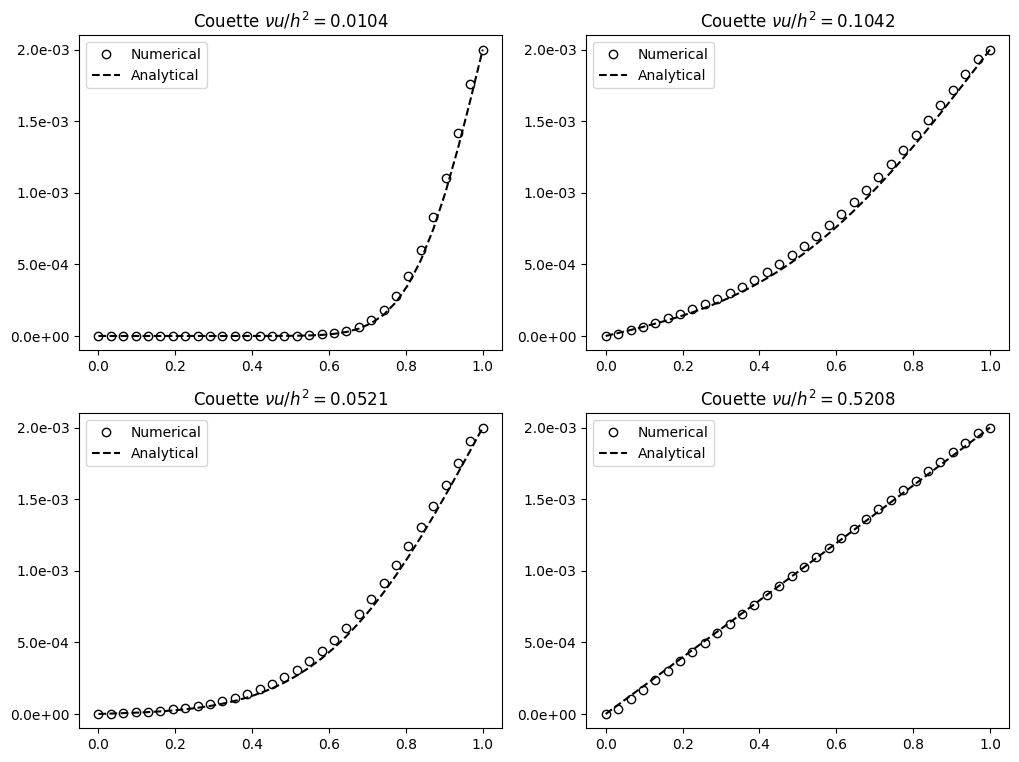Couette (Startup)#
The simulation of a Couette flow is mainly used for validation of the transient flow description through the current collision operator implemented. In this case, the moving wall boundary condition is employed at the \(y=h\) and the halfway bounce-back BC \(y=0\), those BC are therefore also validated.
from nassu.cfg.model import ConfigScheme
filename = "tests/validation/cases/01_couette_flow.nassu.yaml"
sim_cfgs = ConfigScheme.sim_cfgs_from_file_dct(filename)
The simulation parameters are shown below
import pandas as pd
from IPython.display import HTML
sim_cfg = sim_cfgs["startupCouette", 0]
dct = {
"NX": [sim_cfg.domain.domain_size.x],
"NY": [sim_cfg.domain.domain_size.y],
"tau": [sim_cfg.models.LBM.tau],
"time_steps": sim_cfg.n_steps,
}
df = pd.DataFrame(dct, index=None)
HTML(df.to_html())
| NX | NY | tau | time_steps | |
|---|---|---|---|---|
| 0 | 32 | 32 | 0.9 | 4000 |
Results#
The plots of the evolution of velocity profile compared with the analytical solution are shown below
import matplotlib.pyplot as plt
import numpy as np
from typing import Callable
from nassu.cfg.schemes.simul import SimulationConfigs
Processing functions for Couette Flow case
def get_couette_analytical_func(u_wall: float) -> Callable[[float], float]:
"""Couette analytical velocity function"""
return lambda pos: u_wall * pos
def get_adimensional_time(sim_cfg: SimulationConfigs, time_step: int) -> float:
"""Adimensional time"""
nu = sim_cfg.models.LBM.kinematic_viscosity
h = sim_cfg.domain.domain_size.y
return nu * time_step / (h**2)
def get_couette_transient_analytical_func(
sim_cfg: SimulationConfigs, time_step: int, u_wall: float
) -> Callable[[float], float]:
adim_time = get_adimensional_time(sim_cfg, time_step)
def func(y: float):
nonlocal u_wall, adim_time
fix_term = u_wall * y
mul_term = 2 * u_wall / np.pi
terms = []
for n in range(1, 15):
exp_term = -(n**2) * (np.pi**2) * adim_time
sin_term = n * np.pi * (1 - y)
term = ((-(1**n)) / n) * np.exp(exp_term) * np.sin(sin_term)
terms.append(term)
series_sum = sum(terms)
res = fix_term + mul_term * series_sum
return res
return func
def post_proc_couette_time_step(sim_cfg: SimulationConfigs, time_step: int, ax):
line = sim_cfg.output.series["default"].lines["velocity_profile"]
points_df = pd.read_csv(line.points_filename)
data_df = line.read_full_data("ux")
u_wall = sim_cfg.models.BC.BC_map[0].ux
adim_time = get_adimensional_time(sim_cfg, time_step)
transient_func = get_couette_transient_analytical_func(sim_cfg, time_step, u_wall)
ax.set_title(r"Couette $\nu u/h^2=$" + f"{adim_time:.4f}")
x_abs = points_df["y"].to_numpy(dtype=np.float32)
x = (x_abs) / (len(x_abs) - 1)
num_y = data_df[data_df["time_step"] == time_step]
num_y = num_y.drop(columns="time_step").to_numpy().T
ax.plot(x, num_y, "ok", label="Numerical", fillstyle="none")
analytical_y = transient_func(x)
ax.plot(x, analytical_y, "--k", label="Analytical")
Process velocity profiles for some time steps
fig, ax = plt.subplots(2, 2)
fig.set_size_inches(12, 9)
time_steps_proc = [80, 400, 800, 4000]
ax_ticks = [0, 0.0005, 0.001, 0.0015, 0.002]
ax_ticks_label = [f"{x:4.1e}" for x in ax_ticks]
for idx, t in enumerate(time_steps_proc):
i, j = idx % 2, idx // 2
post_proc_couette_time_step(sim_cfg, t, ax[i, j])
ax[i, j].set_yticks(ax_ticks)
ax[i, j].set_yticklabels(ax_ticks_label)
ax[i, j].legend()
plt.show(fig)

The walls have a slight inaccuracy due to the halfway bounce-back not being “rightly” implemented in moments representation.
Despite that, results show a very satisfatory agreement between numerical model and analytical solution, confirming the solver capability to represent a transient flow.
Version#
sim_info = sim_cfg.output.read_info()
nassu_commit = sim_info["commit"]
nassu_version = sim_info["version"]
print("Version:", nassu_version)
print("Commit hash:", nassu_commit)
Version: 1.6.33
Commit hash: fbc0edb5260d2734f0a290e1806c26ac6d865ff4
Configuration#
from IPython.display import Code
Code(filename=filename)
simulations:
- name: startupCouette
save_path: ./tests/validation/results/01_couette_flow/startup_couette
n_steps: 4000
report:
frequency: 500
domain:
domain_size:
x: 32
y: 32
block_size: 8
data:
monitors:
fields:
macrs_stats:
macrs: [rho, u]
stats: [min, max, mean, pos]
interval: { frequency: 100 }
divergence: { frequency: 50 }
instantaneous:
default: { interval: { frequency: 80 }, macrs: [rho, u] }
statistics:
interval: { frequency: 0 }
probes:
historic_series:
default:
interval: { frequency: 80, lvl: 0 }
macrs: [rho, u]
lines:
velocity_profile:
dist: 1
start_pos: [4, 0]
end_pos: [4, 32]
models:
precision:
default: single
LBM:
tau: 0.9
vel_set: D2Q9
coll_oper: RRBGK
engine:
name: CUDA
BC:
periodic_dims: [true, false]
BC_map:
- pos: N
BC: VelocityBounceBack
wall_normal: N
ux: 2e-3
uy: 0
- pos: S
BC: VelocityBounceBack
wall_normal: S
ux: 0
uy: 0
